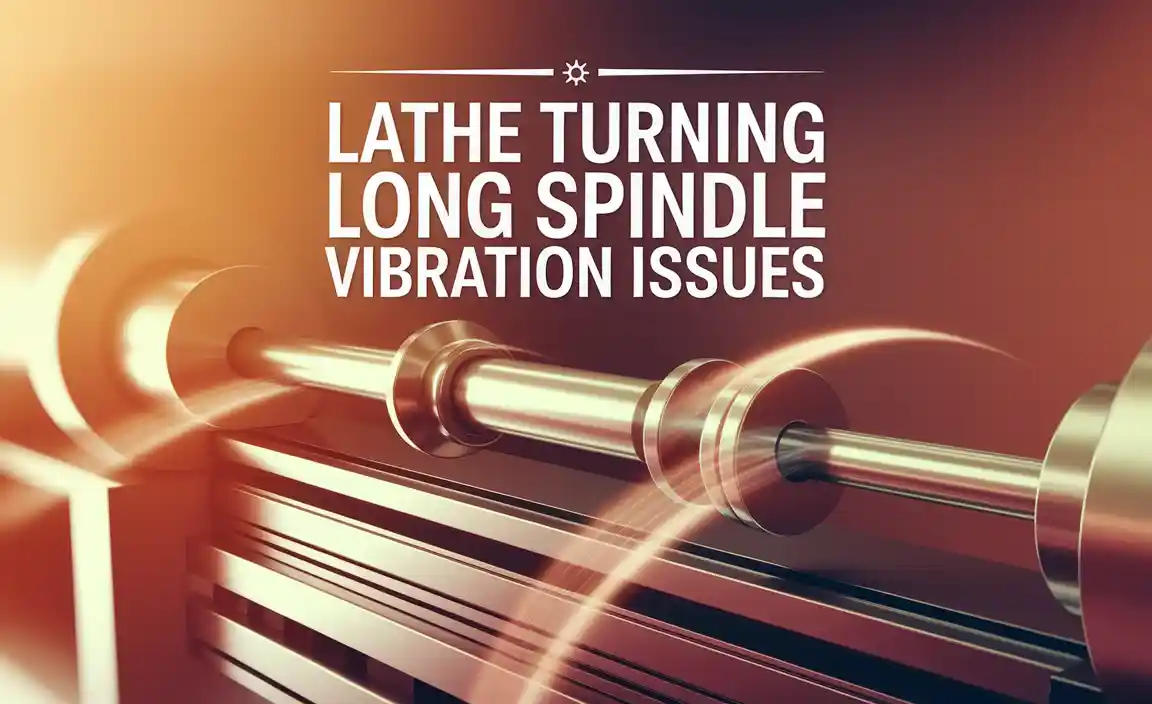Carbide end mills, especially small-diameter long-reach ones for materials like polycarbonate, are key to solving machining deflection, ensuring accuracy and a smooth finish.
It’s a familiar frustration for anyone delving into the world of machining: you’re trying to create a precise shape, perhaps milling a delicate part from polycarbonate, and you notice your tool is bending unexpectedly. This flexing, known as deflection, is a common enemy for hobbyists and seasoned pros alike. It can ruin your part, damage your tooling, and lead to a disappointing finish. But don’t worry! The solution isn’t some secret handshake; it often comes down to choosing the right cutting tool. Specifically, a carbide end mill can be a game-changer, especially when you need to tackle those trickier materials or reach deep into a workpiece. Today, we’ll explore how the right carbide end mill can be your secret weapon against deflection, leading to cleaner cuts and more successful projects. Get ready to learn how to conquer this common machining headache!
What Exactly is Tool Deflection?
In the simplest terms, tool deflection occurs when the cutting forces generated during machining cause your tool to bend or flex away from its intended path. Imagine trying to push a flimsy ruler through a piece of wood; it’s going to bend, right? The same principle applies to your end mill or lathe tool.
Several factors contribute to this bending. The deeper you cut (how much material you’re trying to remove in one pass), and the further the cutting edge is from its support (like the shank of your end mill), the more leverage there is for the material to push back. This is especially true when working with softer, yet sometimes gummy materials like polycarbonate, or when trying to reach into tight spots or make deep slots.
Why is this a big deal? Deflection directly impacts the accuracy of your finished part. If your tool is bending, the resulting cut won’t be the exact size or shape you designed. It also leads to a rougher surface finish, increased tool wear, and can even cause chatter – a vibrating, noisy cutting action that’s bad for both your workpiece and your tools.
Carbide to the Rescue: Why It’s a Deflection Fighter
When we talk about combating deflection, one material stands out for its rigidity and strength: carbide. Carbide, or more formally, tungsten carbide, is a composite material made from tungsten and carbon atoms. It’s renowned for being incredibly hard and stiff, much more so than traditional high-speed steel (HSS).
Think of it like this: if HSS is like a strong metal rod, carbide is like a solid steel bar. That extra stiffness means a carbide end mill is far less likely to bend under the same cutting pressures that would cause an HSS tool to deflect. This inherent rigidity is its superpower against those pesky cutting forces.
The Benefits of Carbide for Machining
- Superior Rigidity: As we’ve discussed, carbide’s stiffness minimizes bending under load, leading to more accurate cuts.
- Higher Hardness: Carbide is significantly harder than HSS, allowing it to maintain its sharp edge for longer, especially in tougher materials.
- Heat Resistance: It can withstand higher cutting temperatures, meaning you can often machine at faster speeds and feeds, reducing machining time.
- Longer Tool Life: Due to its hardness and wear resistance, carbide tools generally last much longer than their HSS counterparts, offering better value over time.
Choosing the Right Carbide End Mill for Your Challenge
So, you’ve decided carbide is the way to go. Great! But not all carbide end mills are created equal. To truly solve deflection problems, especially for specific materials like polycarbonate or when you need to reach deep, a few key features of the end mill are crucial:
1. Diameter and Shank Size
This is perhaps the most direct way to combat deflection. A larger diameter shank provides more resistance to bending. For example, a 1/4 inch (6mm) shank carbide end mill will be significantly more rigid than a 1/8 inch (3mm) shank end mill of the same length.
When machining delicate materials or when very fine detail is needed, minimizing deflection is paramount. If your design allows, opting for the largest shank diameter your machine and workpiece can accommodate is a wise first step. For many desktop CNC machines and smaller milling setups, a 1/8 inch or 1/4 inch shank is common.
2. Length of Cut (LOC) and Overall Length
This is where “long reach” comes into play. The further the cutting flutes extend from the rigid shank of the end mill, the more likely it is to deflect. A standard, short-length end mill will be much stiffer than a long-reach or extended-reach end mill.
If your project requires milling deep pockets or slots, you’ll need an end mill with a significant length of cut. However, this increased length is also its weakness when it comes to deflection. This is precisely why using a carbide end mill in these situations is so important – its inherent stiffness helps counteract the leverage working against it.
Key Terms to Understand:
- Shank: The non-cutting end of the end mill that is held by the collet or tool holder. The larger and shorter this is relative to the cutting flute, the stiffer the tool.
- Length of Cut (LOC): The portion of the end mill that has cutting flutes.
- Overall Length: The total length of the end mill from the tip of the cutting flute to the end of the shank.
3. Flute Count and Design
The number of flutes (the spiraled cutting edges) and their design also play a role in how an end mill cuts and how it handles deflection:
- 2-Flute End Mills: Often preferred for slotting and general-purpose milling. They offer good chip clearance, which is vital in softer materials like polycarbonate that can melt and clog flutes. The fewer flutes mean more space for chips to escape, reducing the chance of the tool getting jammed and deflecting.
- 3-Flute and 4-Flute End Mills: These generally provide a smoother finish and can handle higher feed rates for pocketing and profiling. However, with more flutes come less chip clearance. For materials that produce stringy chips or can melt, like polycarbonate, 2-flute specials are often superior for minimizing deflection and chip evacuation issues.
- Special Coatings: While not always necessary, coatings like TiN (Titanium Nitride) or TiAlN (Titanium Aluminum Nitride) can improve lubricity, reduce friction, and increase tool life, indirectly helping to manage cutting forces and thus deflection.
4. Helix Angle
The helix angle (the steepness of the spiral flutes) affects how the tool engages the material. A steeper helix angle (like around 30-45 degrees) tends to cut more smoothly and with less “ramping” force, which can reduce deflection. However, for some specific gummy materials or when aggressive material removal is needed, a shallower helix might be chosen, but always at the risk of increased deflection.
Carbide End Mills for Polycarbonate: A Case Study
Polycarbonate is a fantastic material for DIY projects due to its toughness and clarity. However, it can be notorious for melting and creating stringy chips when machined. This is where the right carbide end mill truly shines.
For polycarbonate, you typically want an end mill that:
- Is made of carbide: Essential for rigidity and heat resistance.
- Has a 1/8 inch or 1/4 inch (3mm or 6mm) shank: Provides sufficient rigidity for smaller machines. A 6mm shank is generally preferable to a 3mm shank for increased stiffness.
- Is a 2-flute design: This is critical for managing heat and ensuring excellent chip evacuation. Fewer flutes mean larger chip gullets, allowing molten plastic to escape easily, preventing it from welding to the cutter and causing deflection.
- Is a “long-reach” design: If your project requires reaching into a deep cavity, choose a long-reach carbide end mill. While inherently more prone to deflection due to its leverage, the carbide’s rigidity is amplified by optimizing other factors.
- May feature a specialized geometry: Some end mills for plastics are designed with sharp edges and polished flutes to further reduce friction and heat buildup.
When selecting a carbide end mill for polycarbonate, look for terms like “plastic milling,” “acrylic,” or “polycarbonate” in the product description. A common and effective choice for many makers is a 1/8 inch or 1/4 inch (6mm) shank, 2-flute, long-reach carbide end mill. This combination directly addresses the challenges presented by this material and the need for extended reach without excessive deflection.
Machining Strategies to Minimize Deflection
Even with the perfect carbide end mill, smart machining practices are your best friend when it comes to fighting deflection. These strategies help reduce the cutting forces that cause your tool to bend in the first place.
1. Reduce Depth of Cut and Stepover
This is the most fundamental strategy. Instead of trying to remove a lot of material in one go, take lighter passes.
- Depth of Cut (Z-axis): This is how deep the tool cuts vertically into the material per pass. A smaller depth of cut means less force pushing down on the tool.
- Stepover (X/Y-axis): This is how much the tool moves sideways in each pass when milling a larger area. Smaller stepovers also reduce the force on the tool.
For polycarbonate and other challenging materials, starting with a very conservative depth of cut (e.g., 0.010 inches or 0.25mm) and a moderate stepover (e.g., 25-50% of the tool diameter) is a good starting point. You can gradually increase these if your machine and tool are handling it well.
2. Optimize Feed Rate
The feed rate is how fast the tool moves through the material. While it might seem counterintuitive, a feed rate that is too slow can sometimes cause more problems by allowing the tool to rub rather than cut efficiently, leading to heat buildup and increased deflection. A feed rate that is too fast can overload the tool and cause it to break or deflect excessively.
Finding the “sweet spot” for your specific tool, material, and machine is key. Often, manufacturers provide recommended feed and speed charts. Always err on the side of caution and start with slower, more conservative settings.
For polycarbonate, high feed rates with appropriate depth of cut can actually help ‘slice’ through the material, preventing melting. This is sometimes referred to as “climb milling” where the cutter rotates in the same direction as the feed. However, climb milling can also increase deflection on the initial engagement of the tooth into the material, so careful setup is needed.
3. Use Climb Milling vs. Conventional Milling (With Caution)
- Conventional Milling: The cutter rotates against the direction of feed. This creates a thicker chip at the end of the cut, which can be beneficial for chip evacuation but also tends to lift the workpiece and can increase deflection.
- Climb Milling: The cutter rotates in the same direction as the feed. This creates a thinner chip at the end of the cut and generally results in a smoother finish and less deflection once the cut is established. However, the initial engagement of the tooth can cause the tool to “climb” over the material, which can be problematic for deflection if your machine has any backlash (slop in the movement).
For materials prone to melting like polycarbonate, climb milling is often preferred to minimize friction and heat. However, you must ensure your machine has minimal backlash for this to be effective and safe.
4. Support Your Workpiece
Ensure your workpiece is securely clamped and well-supported. Any movement of the workpiece during machining is essentially amplified deflection. If you’re milling a thin sheet of polycarbonate, consider using a sacrifice board underneath and vacuum fixturing if available, or clamping strategically without distorting the material.
5. Machine Lubrication and Cooling
For materials like polycarbonate, a flood coolant system might be overkill and make a mess. However, an air blast or a mist coolant can be very effective at keeping the cutting zone cool. This reduces the tendency for the material to melt and stick to the end mill, which in turn reduces cutting forces and deflection.
For metal machining, a good quality cutting fluid is almost always recommended. It lubricates the cut, cools the tool and workpiece, and helps clear chips. The right cutting fluid can significantly reduce the forces on your end mill.
When to Consider a Carbide End Mill vs. Other Tools
While we’re focusing on carbide end mills, it’s good to know when they are the best choice and when other tools might be appropriate.
Carbide End Mills: The Go-To for Precision and Toughness
- Machining hardened steels, stainless steels, titanium, and exotic alloys.
- Achieving very tight tolerances and superior surface finishes.
- When higher cutting speeds and faster material removal rates are desired.
- Working with plastics like polycarbonate or acrylic where heat management and chip evacuation are critical, especially in longer reach applications.
High-Speed Steel (HSS) End Mills: The Affordable Workhorse
- General-purpose machining of softer metals like aluminum, brass, and mild steel.
- When budget is a primary concern.
- When you need a tool that is tougher and less prone to chipping than carbide (though less rigid).
- Less critical tolerance requirements.
Other Tooling Considerations
For extremely fine detail in soft materials like wood or some plastics, specialized router bits might be used on CNC routers, but these are typically not designed for the forces encountered in metal milling.
A ball end mill is shaped like a ball at the tip and is excellent for milling contoured surfaces and 3D shapes. If you’re using a ball end mill, even a carbide one, deflection can be more pronounced because the cutting forces are applied further from the rigid shank when milling shallow contours.
An o-flute end mill is designed for plastics and has no flutes, relying on the end of the tool to cut. These are excellent for smooth finishes on plastics but are not suitable for conventional milling operations and offer no ability to plunge cut.
Table: Carbide End Mill Features vs. Deflection Impact
Here’s a quick look at how different features of a 1/8 inch (3mm) or 1/4 inch (6mm) shank carbide end mill impact deflection:
| Feature | Impact on Deflection | Recommendation for Minimizing Deflection |
|---|---|---|
| Shank Diameter (e.g., 3mm vs. 6mm) | Larger diameter = Significantly more rigid. Smaller diameter = More prone to deflection. | Always choose the largest shank diameter your setup can handle for the job. A 6mm shank is far superior to a 3mm shank for rigidity. |
| Length of Cut (LOC) | Longer LOC = More leverage = Higher potential for deflection. Shorter LOC = More rigid. | Use the shortest LOC that allows you to complete the operation. If a long reach is necessary, be extra cautious with other parameters. |
| Flute Count (e.g., 2 vs. 4) | Fewer flutes (2) generally provide better chip clearance, reducing binding and potential for deflection while allowing for more aggressive feeds in gummy materials. More flutes (4) offer smoother finish but less clearance. | For materials like polycarbonate that chip and melt, 2-flute carbide end mills are usually best for minimizing deflection. |
| Material (Carbide vs. HSS) | Carbide is vastly more rigid and harder than HSS, offering superior resistance to bending and wear. | Always opt for carbide when deflection is a primary concern, especially with tougher materials or longer reach requirements. |
| Coating | Some coatings can improve surface finish and reduce friction, indirectly helping to manage cutting forces. | Consider coatings for specific materials or improved tool life, but understand they don’t replace the inherent rigidity of the carbide itself. |
Essential Tools and Accessories for Deflection Control
Beyond the carbide end mill itself, having the right supporting tools and accessories can make a world of difference in controlling deflection and ensuring successful machining:
- Quality Collet Chuck or ER Collet System: A worn or low-quality collet can introduce runout (wobble) and reduce the effective rigidity of your tool setup. A high-precision ER collet system will hold your end mill much more securely and accurately. For example, checking your machine’s tool runout is a crucial first step.
- Tool Holder: Using a proper tool holder with your machine’s spindle is essential. Avoid just sticking an end mill in a drill chuck if possible, as drill






